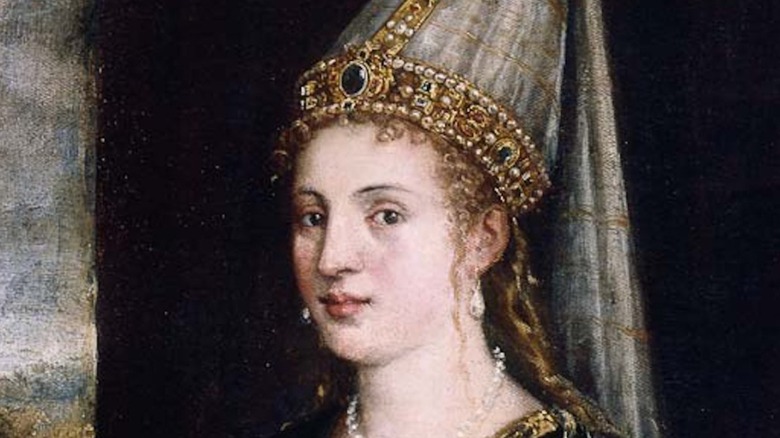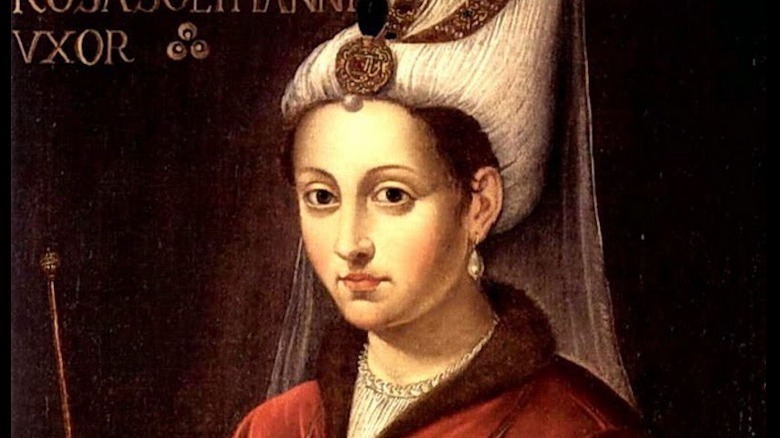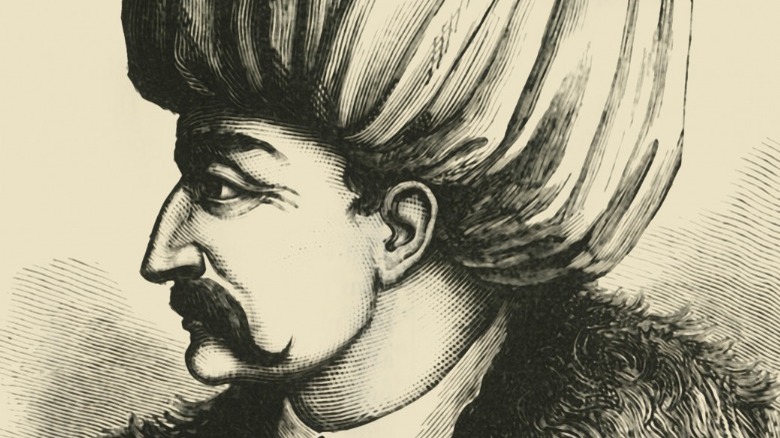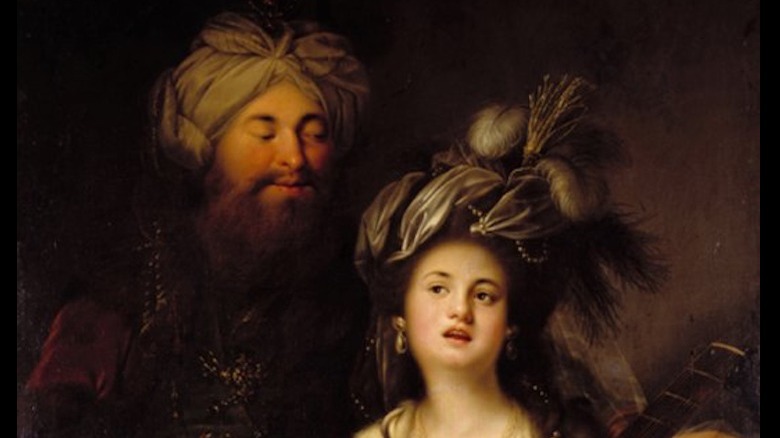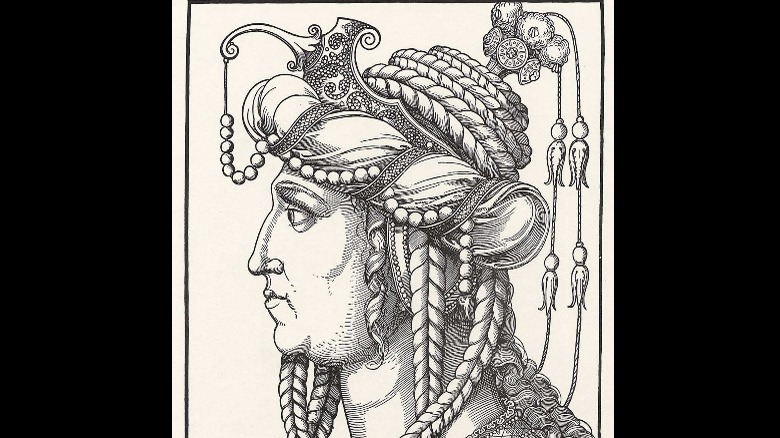How Hurrem Sultan Went From Kidnapped Concubine To Queen Of The Ottoman Empire
Her real name is lost to time: it may have been Alexandra or Anastasia. She's better known to history as Roxelana, or Hurrem Sultan, the wife of Ottoman Sultan Suleyman the Magnificent (via Britannica). Hurrem climbed from obscurity, survived enslavement, and became one of the most powerful women of her time.
Hurrem was probably born around 1505 in Rohatyn, then part of Poland, now part of Ukraine. Her family name may have been Lisovska. The Collector notes a theory that she was the daughter of an Orthodox Christian priest and later forcibly converted to Islam. She was likely kidnapped by Crimean Tatars and taken to Caffa to be sold. The Ottoman Empire owned the market for enslaved people at Caffa, which is probably why she was then taken to Constantinople (now Istanbul). The trajectory of her life changed again when she was bought by Pargalı Ibrahim Pasha as a gift for his friend Suleyman, the current sultan's son (via The Collector).
Captivating the future sultan
The Collector notes that Hurrem Sultan had an advantage over other enslaved people because she was young and attractive. Venetian ambassadors later described her as not beautiful but slender and graceful. They may also have been the ones who named her Roxelana, which means "maid from Ruthenia" (her region of Poland). She also had an advantage over other women in the sultan's harem because she was fair-skinned and red-haired, which made her stand out in the Ottoman Empire.
There are varying stories as to how she met Suleyman, the future sultan. There were so many women in the royal harem that many never met the royal family. One story says she was chosen by Suleyman's mother — probably for her exotic looks – and taken to spend the night with him. Another says she was initially put to work as a laundress in the royal household; in this story, Suleyman was walking near where she was working and was enchanted by the sound of her voice as she sang a Russian folk song. He stopped to talk to her and was captivated by her wit, which is reflected in the name Hurrem, which means "joyful" or "the laughing one" in Persian. However they met, Hurrem soon became Suleyman's favorite concubine, replacing Mahidevran, mother of Suleyman's son (via The Collector).
Who was Suleyman the Magnificent?
According to Britannica, Suleyman became sultan in 1520, a year before his first child with Hurrem was born. He was then 26 years old. He was the only son of the previous sultan, Selim I. One of Suleyman's goals as sultan was to expand his empire. During his life, he would capture Belgrade (in modern Serbia) and Rhodes (in modern Greece), as well as parts of modern Hungary and Iraq (via Britannica).
He was introduced to government at an early age. His grandfather appointed him governor of Kaffa in Crimea, and later, his father named him governor of Manisa, Turkey. Britannica says he undertook public works during his reign as well, including commissioning the construction of fortresses, mosques, bridges, and aqueducts in various cities in his empire. In later years, Suleyman had to witness more family in-fighting as his sons by Hurrem — Selim and Bayezid – battled for the succession. Selim was ultimately successful (via Britannica).
Hurrem and Suleyman's family life
As Hurrem rose to prominence, Suleyman's previous favorite, Mahidevran, attacked her and scratched her face. According to The Collector, this backfired: the incident only cemented Hurrem's place as the new favorite. Hurrem had her first child by Suleyman in 1521 — a son, Mehmed. She eventually gave him five sons and a daughter. Normally, concubines were only supposed to give the sultan one son and then focus completely on his upbringing. But Hurrem was constantly breaking the rules. For instance, she convinced him to let her live with him in the Topkapi Palace instead of the separate harem house.
Most surprisingly, Suleyman eventually forsook all other women for Hurrem, according to The Collector. He even freed her from slavery so he could marry her. Since concubines' sons could inherit the throne anyway, this was an unprecedented move. The Genoese ambassador wrote at the time, "This week there has occurred in this city a most extraordinary event ... The Grand Signior Suleiman has taken to himself as his Empress a slave-woman from Russia, called Roxolana."
Hurrem and Suleyman were, by all accounts, truly in love. They wrote each other letters and poetry when they were apart. One of Hurrem's surviving letters says (via The Collector), "I only find peace next to you. Words and inks would not be enough to tell my happiness and joy, when I am right next to you."
Hurrem's political plots
Hurrem probably didn't want to relinquish her newfound prestige and power. She was suspected of ordering the assassination of some of her and her children's political rivals. One of her letters to Suleyman, quoted in the Encyclopedia of the Ottoman Empire, shows that she was angry with Ibrahim Pasa, Suleyman's chief advisor and close friend. Because Suleyman later had Pasa executed, some believed that Hurrem was the instigator. The encyclopedia notes that this may have been because he was a threat to her children's succession to the throne. However, Ottoman History disputes this claim while also noting the possible involvement of Rustem, Hurrem's son-in-law and ally. He later became grand vizier in Pasa's place (via Britannica).
Hurrem was also believed to have influenced the sultan to order the execution of his eldest son, Mustafa. Rustem may have also conspired with her in this. Again, their goal would have been the promotion of Hurrem's children as heirs to the throne. However, Ottoman History says that Mustafa was already pretending to be the sultan, with his friends encouraging him to seize power. That allegedly aroused his father's suspicion. The book "Extraordinary women of the Medieval and Renaissance world" states unequivocally that the decision to execute Mustafa was Suleyman's alone and that he actually watched his son die.
Hurrem's public projects
At the same time, Hurrem was also doing a lot of good for her husband's empire. According to Britannica, she corresponded with foreign politicians, including Sigismund II Augustus, the king of Poland, and the wife and sister of Tahmasp I, shah of Persia. She also kept her husband informed about what was happening in Constantinople while he was away (via The Collector).
Meanwhile, she commissioned civic projects, including enlisting the royal architect, Sinan, to build the Haseki Sultan Complex, which included a mosque (interior pictured), two schools, and a hospital (via Britannica). The complex exists to this day in Istanbul, as do the public baths she commissioned. She was also a patron of the arts and worked on charitable projects like the establishment of a soup kitchen for the poor.
Hurrem died in 1558, about eight years before her husband. She asked to be buried next to him, and they now have adjacent mausoleums in the Suleymaniye Mosque (via The Collector). The next 100 years in the Ottoman Empire were known as "the Sultanate of Women" because the royal women of the time exerted so much influence over the men. They were following in Hurrem's extraordinary footsteps.
